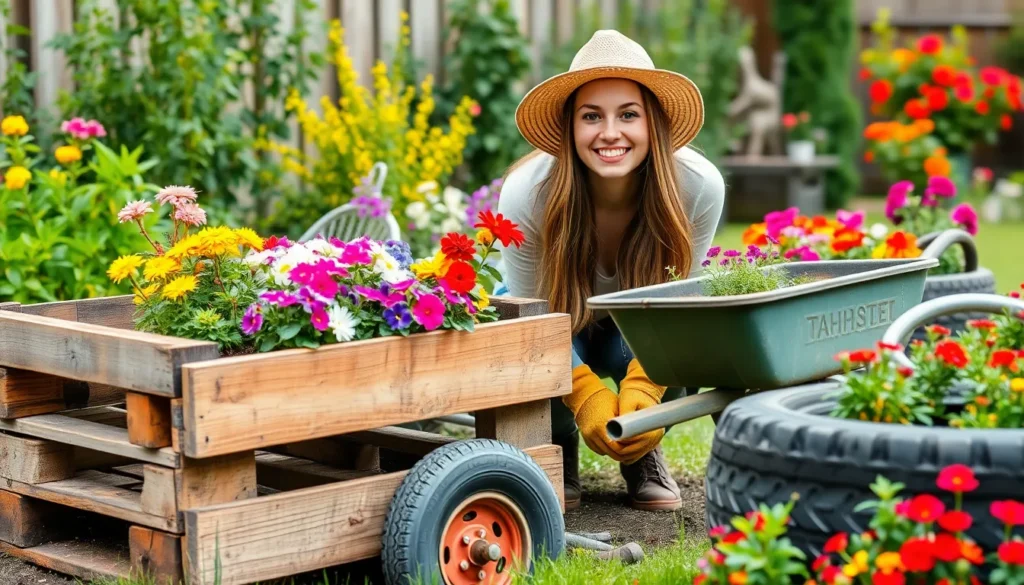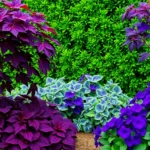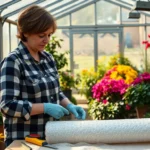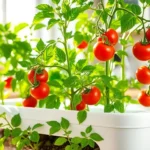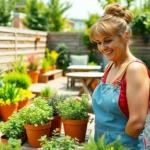We’ve all stared at that pile of “junk” in our garage wondering what to do with it. Instead of tossing those old items into the trash we can transform them into stunning garden features that’ll make our neighbors green with envy. Garden upcycling isn’t just about saving money – it’s about unleashing our creativity while giving discarded materials a beautiful second life.
From rusty wheelbarrows turned into charming planters to worn-out boots reimagined as quirky flower pots we’re about to show you how everyday items can become garden masterpieces. These brilliant upcycling projects will help us create unique outdoor spaces that reflect our personality while keeping useful materials out of landfills.
Ready to turn trash into garden treasure? We’ve gathered the most inspiring and practical upcycling ideas that’ll transform both our gardens and our perspective on what’s possible with a little imagination.
Transform Old Pallets Into Garden Planters and Furniture
Pallets offer endless possibilities for creating stunning garden features that cost practically nothing. We can transform these wooden shipping materials into functional planters, seating, and vertical growing spaces that add rustic charm to any outdoor area.
Vertical Pallet Garden Walls
Vertical pallet walls maximize growing space while creating eye-catching garden displays. We simply stand pallets upright against fences or walls, then fill the slat spaces with potting soil and small plants like succulents, herbs, or trailing flowers.
Preparation steps make installation simple:
- Sand rough edges to prevent splinters and create a smooth finish
- Apply weather-resistant wood stain or sealant to extend the pallet’s lifespan
- Staple industry fabric to the back to contain soil while allowing drainage
- Mount securely to walls using heavy-duty brackets or lean against stable surfaces
Strawberry plants thrive in vertical pallet gardens, cascading beautifully through the wooden slats. Lettuce, spinach, and other leafy greens also flourish in these space-saving structures, providing fresh produce throughout the growing season.
Pallet Herb Garden Boxes
Pallet herb boxes create convenient growing stations that bring fresh flavors within arm’s reach of our kitchens. We disassemble pallets and reconstruct the boards into rectangular raised beds that fit perfectly on patios, decks, or garden paths.
Construction requires basic carpentry skills:
- Remove pallet boards carefully to preserve their natural weathered appearance
- Cut boards to desired lengths for box sides, typically 24 to 36 inches
- Assemble corners using wood screws and metal corner brackets for stability
- Line the bottom with hardware cloth to prevent pests while ensuring proper drainage
Culinary herbs like basil, oregano, thyme, and rosemary perform exceptionally well in pallet herb boxes. We can create themed gardens by grouping Mediterranean herbs together or mixing cooking essentials like parsley, chives, and cilantro in single containers.
Rustic Pallet Garden Benches
Pallet benches provide comfortable seating while maintaining the reclaimed wood aesthetic that complements garden upcycling themes. We stack two pallets for the base and add a third pallet as the backrest, creating sturdy outdoor furniture for relaxation and garden contemplation.
Assembly creates durable seating options:
- Select pallets in good condition without broken boards or protruding nails
- Stack base pallets and secure with carriage bolts for maximum stability
- Attach backrest pallet at a comfortable angle using metal hinges
- Sand all surfaces smooth and apply outdoor wood finish for weather protection
Cushions made from outdoor fabric transform basic pallet benches into inviting garden retreats. We can add storage functionality by leaving the bottom pallet open, creating space for garden tools, watering cans, or plant supplies beneath the seating area.
Repurpose Plastic Containers for Creative Plant Displays
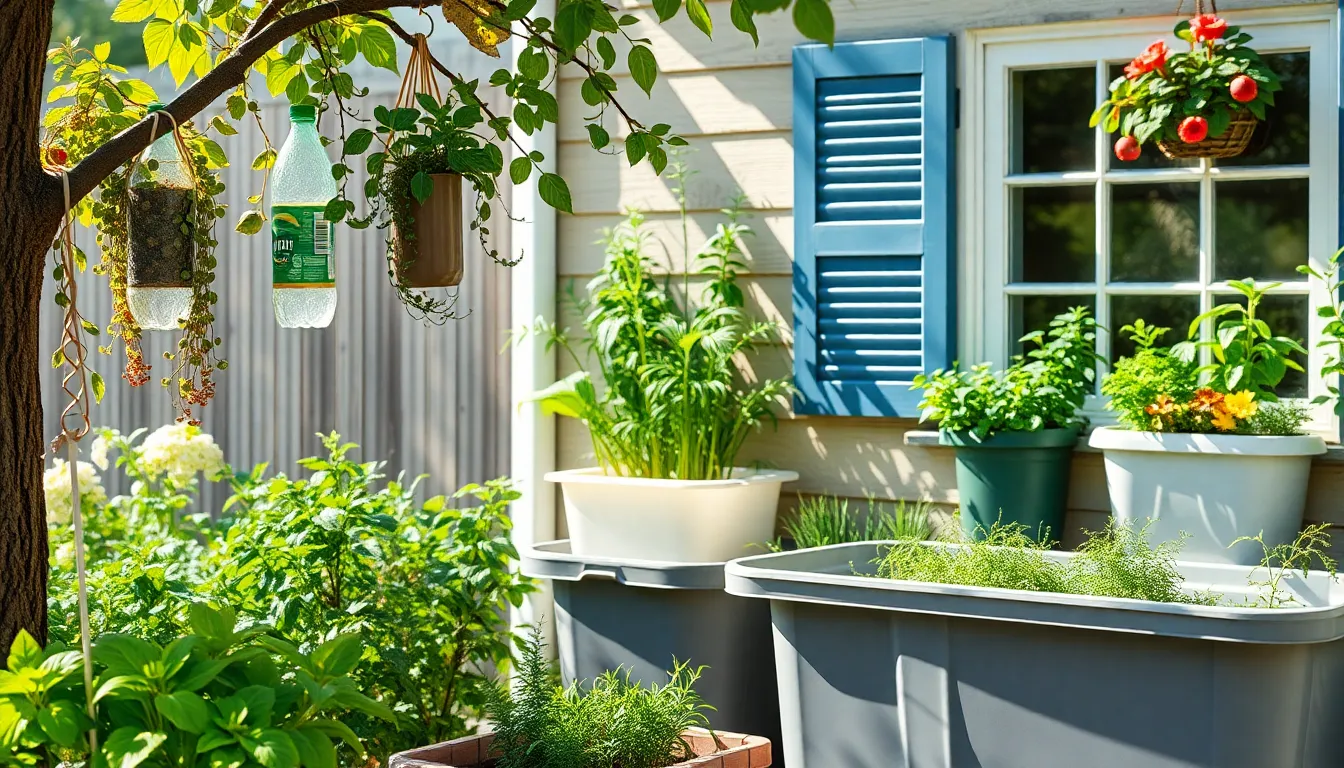
Plastic containers offer endless possibilities for creating unique plant displays while keeping these materials out of our landfills. We can transform ordinary household items into eye-catching garden features that rival expensive store-bought alternatives.
Plastic Bottle Hanging Planters
Plastic bottles make excellent hanging planters when we cut off the bottom and add a sturdy string for suspension. We simply need to puncture a few drainage holes in the cap area before filling the inverted bottle with potting soil. This technique works particularly well for trailing plants like cherry tomatoes or strawberry plants that naturally cascade downward.
Installation becomes straightforward when we hang these planters from tree branches or wall hooks throughout our garden space. We can create stunning vertical displays by arranging bottles at different heights along fence lines or pergola structures. The transparent nature of plastic bottles also allows us to monitor root development and soil moisture levels easily.
Yogurt Container Seed Starters
Yogurt containers transform into perfect mini greenhouses for our seedling projects with minimal preparation required. We fill these containers with quality seed starting mix and plant our chosen varieties directly inside. The clear plastic lids that come with many yogurt containers create an ideal humid environment for germination.
These containers provide optimal growing conditions because we can control moisture and temperature more effectively than with traditional seed trays. We place them in sunny windowsills or under grow lights until our seedlings develop strong root systems. Once our plants outgrow these starter homes, we transplant them directly into our garden beds or larger containers.
Large Plastic Tub Raised Beds
Large plastic tubs serve as instant raised bed answers when we drill adequate drainage holes in the bottom. We can position these portable growing spaces anywhere in our yard that receives appropriate sunlight for our chosen plants. This approach works exceptionally well for renters or anyone wanting to create temporary garden installations.
These tub gardens excel at containing sprawling plants like herbs, lettuce, or compact vegetable varieties. We fill them with high quality potting mix and arrange them at comfortable working heights to reduce bending and kneeling. The contained environment also helps us maintain better soil moisture and prevents weeds from infiltrating our growing space.
Convert Old Tires Into Functional Garden Features
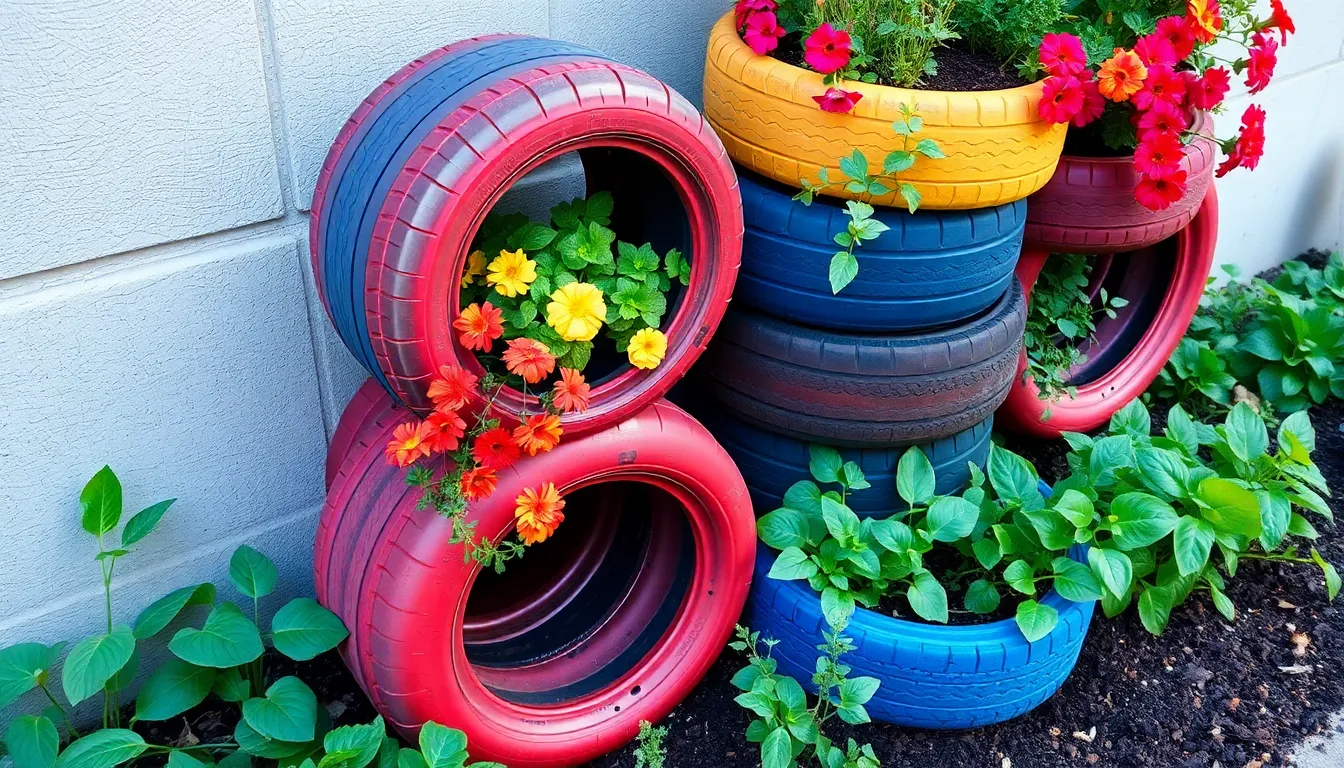
Old tires offer incredible versatility for creating durable, weather-resistant garden features that’ll last for years.
Stacked Tire Planters
Stacked tire planters create impressive vertical growing spaces using materials you’d otherwise discard. We recommend starting with three to four clean tires of similar sizes, which you can paint in bright colors or leave natural for a rustic look. Fill the bottom tire completely with quality potting soil, then add the second tire and continue layering soil and tires to your desired height.
These planters work exceptionally well for potatoes, strawberries, and cascading flowers like petunias or trailing nasturtiums. The rubber material retains heat effectively, extending your growing season and protecting roots during cooler months. You can also create different sized towers by mixing tire sizes, placing larger tires at the bottom and progressively smaller ones on top.
Tire Swing Herb Gardens
Tire swing herb gardens combine childhood nostalgia with practical growing space in a truly unique way. We suggest selecting a sturdy tree branch at least 8 feet high and 6 inches in diameter to support the weight of soil and plants. Drill drainage holes around the bottom edge of your tire, then line it with industry fabric to prevent soil from washing out.
Fill your suspended garden with lightweight potting mix and plant compact herbs like thyme, oregano, and trailing rosemary. The gentle swaying motion actually benefits many herbs by improving air circulation around the plants. You’ll find harvesting becomes a delightful experience as you can easily rotate the planter to reach herbs on all sides.
Painted Tire Border Edging
Painted tire border edging transforms ordinary garden beds into vibrant, defined spaces using colorful tire sections. We cut tires in half lengthwise using a reciprocating saw, then paint them with exterior latex paint in colors that complement our garden design. Popular choices include bright blues, sunny yellows, and classic whites that make flower colors pop.
Install these painted borders by digging a shallow trench and setting the curved tire sections with the cut edge facing down into the soil. They create excellent barriers for mulch and help prevent grass from creeping into flower beds. The flexible rubber material follows curved garden lines perfectly, making it ideal for creating flowing, organic shaped borders around trees and irregularly shaped planting areas.
Upcycle Kitchen Items for Garden Organization
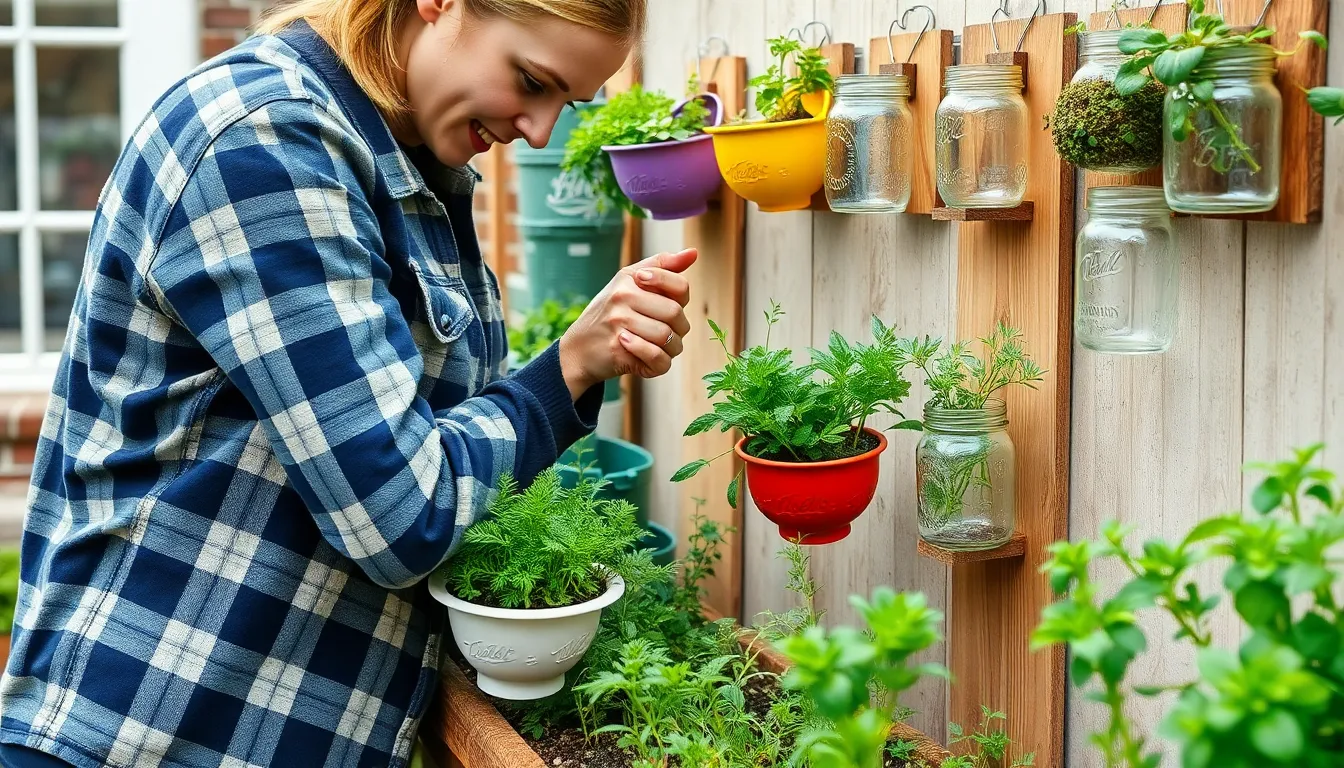
We can transform everyday kitchen items into practical garden answers that organize our outdoor spaces while reducing household waste. These creative approaches give new life to items we might otherwise discard.
Colander Hanging Baskets
Colanders make excellent hanging baskets for small plants and herbs. The built-in drainage holes eliminate the need for drilling and ensure proper water flow to prevent root rot. Vintage or worn colanders work particularly well since their aged appearance adds rustic charm to garden displays.
Hanging these repurposed baskets requires simple materials like twine or chains. We can suspend them from fences, pergolas, or balcony railings to create eye-catching vertical displays. Small herbs like oregano, thyme, and trailing plants like ivy thrive in these containers due to the excellent drainage and air circulation.
Position colander baskets at eye level for easy harvesting. The perforated design allows us to monitor soil moisture and root health while providing adequate drainage that traditional solid containers can’t match.
Mason Jar Storage Answers
Mason jars provide clear visibility for organizing garden essentials. We can store seeds, small tools, plant clips, and other accessories in these versatile containers. Mounting multiple jars on wooden boards or arranging them in crates creates accessible storage systems.
Inverted mason jars function as mini cloches for protecting seedlings. This method shields young plants from pests and harsh weather while allowing light penetration. The glass construction creates a greenhouse effect that promotes healthy growth during vulnerable early stages.
Labeling mason jars keeps garden supplies organized throughout growing seasons. We can use waterproof markers or adhesive labels to identify contents and planting dates. Clear glass allows us to quickly assess quantities without opening containers.
Coffee Can Plant Markers
Coffee cans transform into durable plant markers through simple cutting and shaping. We can slice the metal containers open and form them into tags or stakes for plant identification. The weather-resistant material withstands outdoor conditions better than paper or plastic alternatives.
Painting coffee can markers adds color coordination to garden beds. Permanent markers or outdoor paint allow us to customize labels with plant names, planting dates, or care instructions. The metal surface accepts various marking materials for long-lasting identification.
These repurposed markers reduce waste while providing unique garden character. Empty coffee cans that would typically go to landfills become functional tools that help us track plant varieties and garden progress throughout growing seasons.
Repurpose Furniture Pieces as Garden Decor
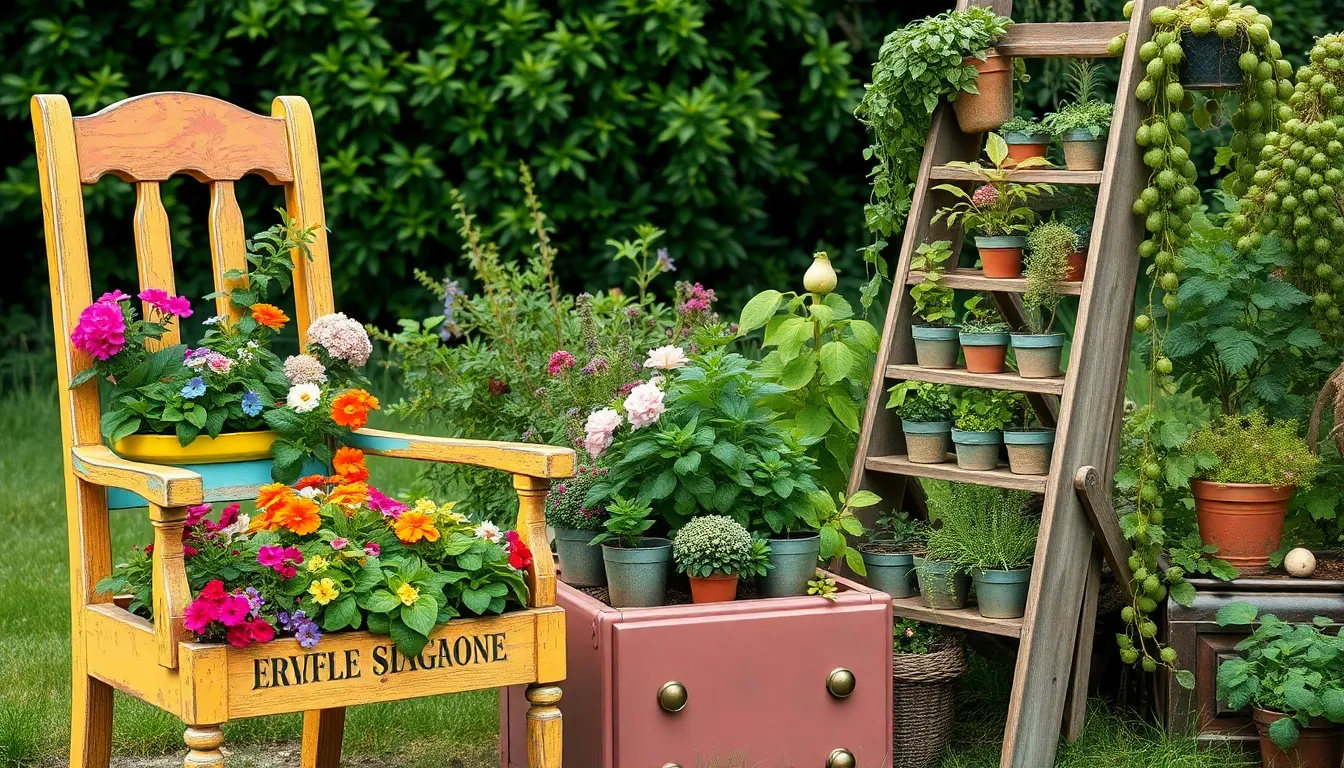
Furniture pieces that have outlived their indoor purpose can find new life as stunning garden elements. We’ll transform these forgotten items into functional decorative features that add character while supporting our sustainable gardening goals.
Dresser Drawer Planters
Dresser drawers create perfect raised planters when properly prepared for outdoor use. Old wooden drawers need waterproof lining or drainage holes drilled into the bottom to prevent water damage and root rot. We can arrange multiple drawers in tiers to build vertical growing spaces that maximize limited garden areas.
Small herb gardens thrive in these repurposed containers because the contained space provides excellent soil control. Patios and decks benefit from standalone drawer planters that offer rustic charm without permanent installation. The natural wood texture complements both modern and traditional garden designs while providing functional growing space for shallow rooted plants.
Chair Planter Displays
Chairs with missing seats become whimsical planters that add vertical interest to garden spaces. We replace the damaged seat area with a custom planter box or fill it directly with potting soil to create living furniture. Flowers like petunias or trailing succulents work beautifully in these elevated displays.
Stacked chairs create dramatic height variations that draw the eye upward through garden beds. Painted finishes in bright colors transform worn furniture into focal points that reflect our personal style. Weather resistant paint extends the life of these upcycled pieces while protecting them from outdoor elements.
Ladder Plant Stands
Ladders provide excellent vertical growing space for trailing plants and potted collections. We can lean old step ladders against garden walls or fences to create living wall effects that maximize growing area. Each rung supports different sized containers while maintaining easy access for watering and maintenance.
Wooden ladders work particularly well for displaying lanterns and garden accessories alongside plants. The rungs create natural shelving that accommodates various pot sizes from small herb containers to larger flowering plants. Trailing varieties like ivy or morning glories enhance the vertical structure while softening the rigid ladder lines with natural growth patterns.
Transform Household Containers Into Watering Solutions
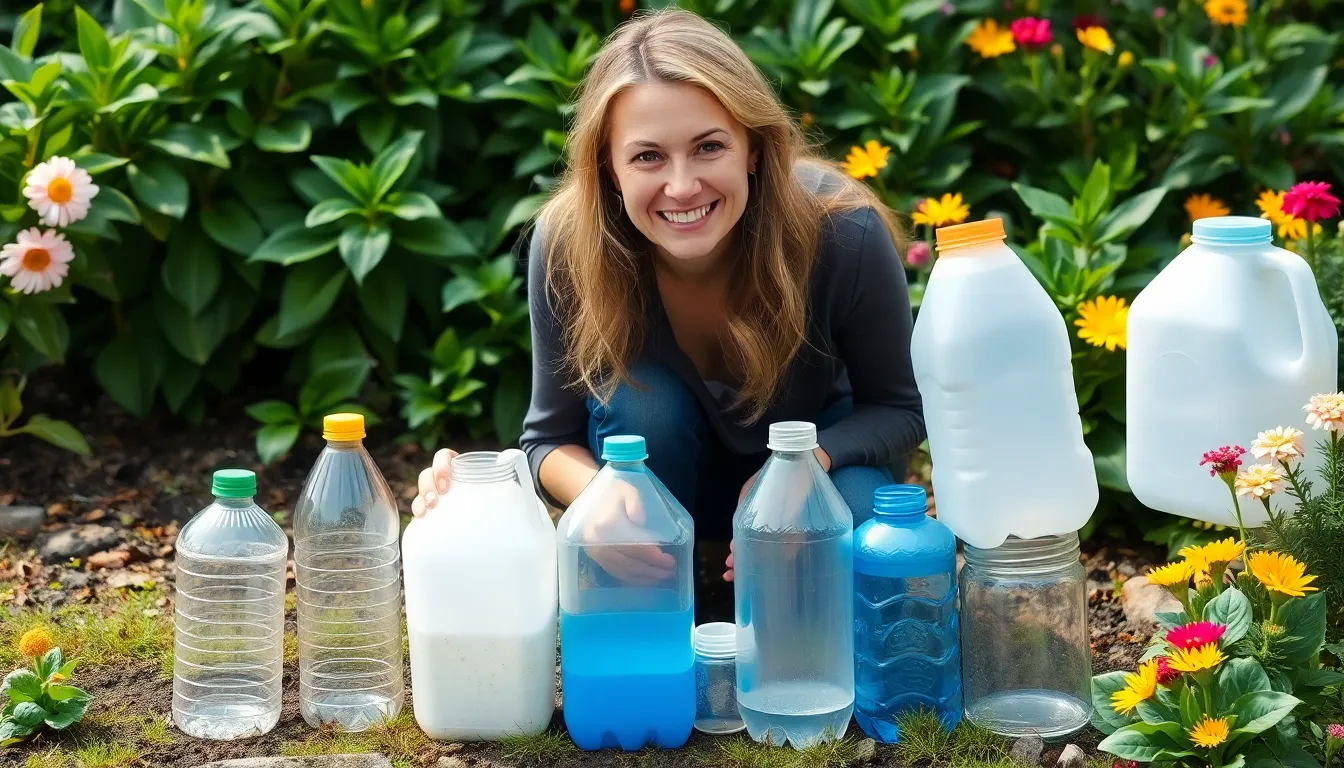
We’re discovering that the most effective watering systems often come from containers we’d normally toss in the recycling bin. These household items can become ingenious irrigation answers that keep our plants perfectly hydrated while we save money and reduce waste.
Plastic Bottle Drip Irrigation
Plastic bottles create the perfect drip irrigation system that delivers water exactly where your plants need it most. Cut the bottom off any plastic bottle, fill it with water, and place it upside down directly into the soil near your plant’s root zone. As the soil dries out naturally, it draws water from the bottle at precisely the right rate to prevent both overwatering and drought stress.
This self-regulating system works beautifully for tomatoes, peppers, and other thirsty vegetables that need consistent moisture. We’ve found that 2-liter bottles work best for larger plants, while 16-ounce bottles are perfect for herbs and smaller container plants. The beauty of this method lies in its simplicity: no timers, no electricity, and no guesswork about when to water.
Milk Jug Self-Watering Systems
Milk jugs transform into reliable self-watering systems that can keep your plants hydrated for days at a time. Drill a small hole in the cap (about 1/8 inch works perfectly), fill the jug with water, and nestle it into the soil beside your plant with the cap end down. Water slowly seeps through the hole as the surrounding soil needs moisture, creating a steady supply that mimics natural rainfall patterns.
These systems excel in raised beds and large containers where consistent moisture is crucial for plant health. We recommend positioning the jug about 6 inches from the plant’s main stem to ensure even water distribution throughout the root zone. During hot summer months, a single milk jug can provide adequate moisture for up to a week, making it ideal for vacation watering.
Wine Bottle Plant Waterers
Wine bottles become elegant plant waterers that combine function with aesthetic appeal in our garden spaces. Fill the bottle with water, thread a cotton wick or cloth strip through the neck opening, and insert the bottle into the soil at an angle with the wick extending into the root zone. Water travels down the wick as the soil dries, delivering moisture directly to where plants can absorb it most efficiently.
This method works exceptionally well for indoor plants and outdoor containers that need gentle, consistent watering. We’ve discovered that darker bottles work better because they prevent algae growth inside the water reservoir. The slow-release nature of this system makes it particularly valuable for sensitive plants like orchids, ferns, and seedlings that can’t tolerate fluctuating moisture levels.
Create Garden Pathways From Reclaimed Materials
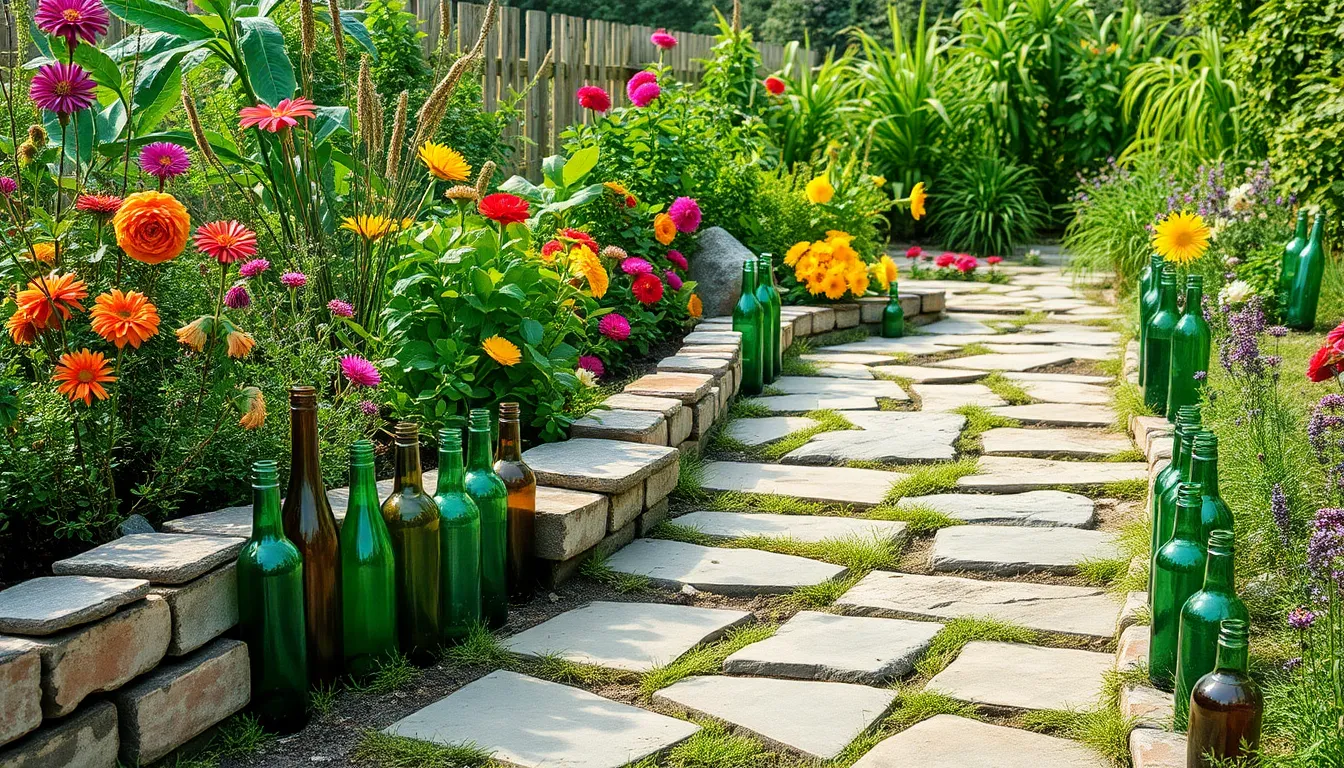
We’ll discover how discarded construction materials can become beautiful garden walkways that add character to our outdoor spaces while keeping waste out of landfills.
Broken Concrete Stepping Stones
Broken concrete pieces transform into unique stepping stones that create charming pathways through our gardens. We clean the concrete chunks thoroughly and arrange them along our desired route to form an irregular but appealing walkway. Varying sizes of concrete pieces add visual interest while providing stable footing for garden visitors.
These reclaimed stepping stones work particularly well in informal garden settings where we want a natural, weathered appearance. We can space them evenly for a structured look or place them irregularly for a more organic pathway design. Moss and small plants naturally grow between the stones over time, creating a lived-in garden aesthetic.
Old Brick Walkway Designs
Old bricks repurpose beautifully into charming walkways that bring rustic elegance to our garden spaces. We arrange these reclaimed bricks in traditional patterns like herringbone or running bond, or simply lay them end to end for a casual country look. Weathered bricks develop unique patina and character that new materials can’t replicate.
Salvaged bricks from demolished buildings or construction sites often come free or at minimal cost compared to purchasing new materials. We level the ground first, then lay the bricks on a sand base for proper drainage and stability. Gaps between bricks allow for natural plant growth that softens the pathway edges.
Recycled Glass Bottle Borders
Recycled glass bottles create stunning decorative borders around our garden beds when arranged in trenches along pathway edges. We dig shallow trenches approximately 6 inches deep and fill them with colorful glass bottles placed neck down for stability. Different colored bottles like green wine bottles, brown beer bottles, and clear mason jars create beautiful light effects.
These bottle borders catch sunlight during the day and can reflect garden lighting at night for added ambiance. We ensure bottles are thoroughly cleaned before installation and pack soil firmly around them to prevent shifting. This creative border solution costs virtually nothing while adding distinctive visual appeal to our garden pathways.
Upcycle Textiles for Garden Protection and Decor
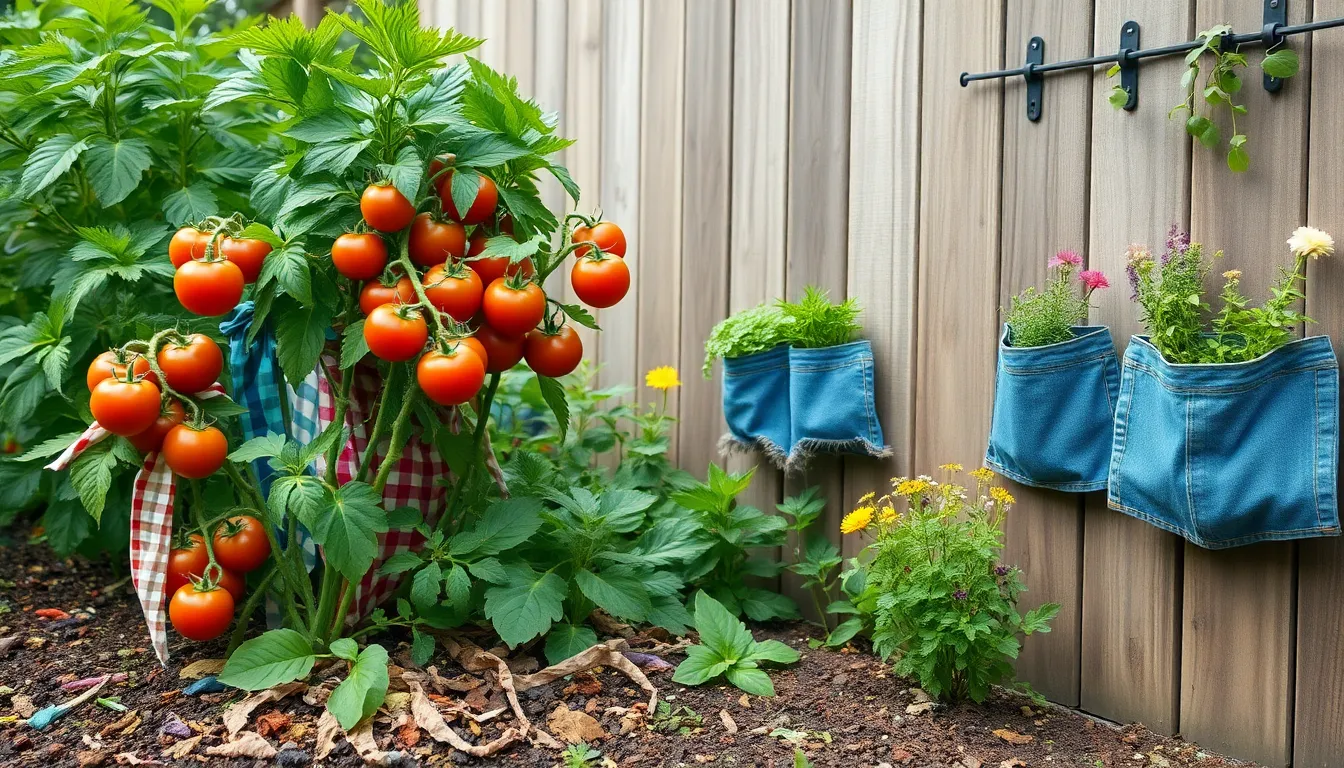
We can transform worn out fabrics into functional garden accessories that protect plants while reducing textile waste. Our textile gardens benefit from creative answers that repurpose clothing and fabric scraps.
Old Shirt Plant Ties
Cotton shirts make excellent plant ties because their soft fabric won’t damage delicate stems or bark. We simply cut old t-shirts and dress shirts into strips about 1-2 inches wide to create flexible ties for tomatoes, climbing roses, or young trees.
Stretchy materials work particularly well since they expand as plants grow without cutting into the stems. We prefer using colorful shirts to add visual interest while providing sturdy support for heavy branches or tall flowering plants.
Natural fibers like cotton and linen break down slowly over time, making them environmentally friendly alternatives to plastic zip ties. Our fabric ties can support plants throughout an entire growing season before needing replacement.
Fabric Scrap Mulch Alternatives
Cotton and linen scraps create effective mulch layers that retain soil moisture while suppressing weeds naturally. We arrange fabric pieces around plant bases in 2-3 inch layers, ensuring they don’t touch plant stems directly.
Breathable fabrics allow water and air to penetrate the soil while blocking sunlight from reaching weed seeds. We use old bedsheets, worn towels, and cotton clothing scraps to cover large garden bed areas effectively.
Dark colored fabrics absorb heat during the day and release it slowly at night, helping extend growing seasons for temperature sensitive plants. Our fabric mulch alternatives last 6-12 months before decomposing naturally into the soil.
Denim Pocket Planters
Sturdy denim pockets from old jeans create charming mini planters perfect for herbs, succulents, or small flowering plants. We carefully remove pockets from worn jeans and reinforce any loose seams before adding drainage holes in the bottom corners.
Heavy duty denim withstands outdoor weather conditions better than lighter fabrics, making pocket planters suitable for year round use. We fill pockets with potting soil and plant small varieties like cherry tomatoes, trailing herbs, or compact flowers.
Multiple pockets can be arranged on fences, garden walls, or wooden boards to create vertical growing displays that maximize planting space. Our denim planters develop attractive weathered appearances over time while maintaining their structural integrity for several growing seasons.
Conclusion
We’ve shown you how simple household items can become extraordinary garden features with just a little creativity and effort. From pallets and tires to kitchen containers and old textiles every discarded item holds potential for your outdoor space.
These upcycling projects don’t just save money – they help us reduce waste while creating one-of-a-kind gardens that truly reflect our personalities. The best part? Most of these ideas require minimal tools and can be completed in a weekend.
Start small with one or two projects that excite you most. Once you see how rewarding garden upcycling can be you’ll find yourself looking at everyday items with fresh eyes and endless possibilities.
Your garden transformation awaits – and it’s probably sitting in your garage or closet right now.
Frequently Asked Questions
What is garden upcycling?
Garden upcycling is the creative practice of repurposing old, discarded items into functional and beautiful garden features. Instead of throwing away “junk” like rusty wheelbarrows, worn boots, or broken furniture, you transform them into planters, decorations, and garden tools. This sustainable approach keeps materials out of landfills while creating unique outdoor spaces that reflect your personality.
How can I use old pallets in my garden?
Old pallets are incredibly versatile for garden projects. You can transform them into vertical planters, herb garden boxes, rustic benches, or seating areas. Start by cleaning and sanding the pallets, then add landscape fabric for planting areas. They’re perfect for creating raised beds, storage solutions, or even decorative garden walls at minimal cost.
What plastic containers work best for garden upcycling?
Large plastic containers like storage tubs make excellent portable raised beds, while smaller bottles can become hanging planters. Milk jugs work great for self-watering systems, and plastic bottles can create drip irrigation systems. Always ensure containers have proper drainage holes and choose food-grade plastics when growing edibles.
How do I create planters from old tires?
Stack tires to create tiered planters of varying heights, or use single tires for individual plant containers. Clean tires thoroughly, paint them if desired, and fill with quality potting soil. You can also hang tires horizontally to create unique swing-style herb gardens. Ensure proper drainage by drilling holes in the bottom.
Can kitchen items be repurposed for gardening?
Yes! Colanders make excellent hanging baskets with built-in drainage, while mason jars organize seeds, tools, and plant labels. Old spoons become plant markers, and worn-out shirts can be cut into plant ties. Large pots and pans work as unique planters, and kitchen containers can store garden supplies efficiently.
How can I upcycle furniture for garden use?
Transform dresser drawers into raised planters by adding drainage holes and lining with landscape fabric. Old ladders become rustic plant stands for displaying potted plants at different heights. Chairs can hold large planters, and tables serve as potting stations. Always treat wood furniture with weather-resistant sealant for outdoor use.
What textile items can be upcycled for gardening?
Old shirts and fabric scraps make excellent plant ties and soft supports for growing plants. Denim pockets can be sewn together to create unique vertical planters. Worn towels and sheets work as protective plant covers during cold weather, while fabric scraps can substitute for traditional mulch around plants.
How do I create garden pathways from reclaimed materials?
Broken concrete pieces can be arranged as stepping stones or fitted together like puzzle pieces. Old bricks create charming walkways when laid in sand or directly on soil. Clean materials thoroughly, level the ground, and consider adding sand or gravel as a base for stability and drainage.
Are there safety concerns with garden upcycling?
Yes, always inspect items for sharp edges, rust, or toxic materials. Avoid containers that held chemicals or non-food products for edible plants. Sand rough surfaces, apply rust treatments when needed, and ensure structural stability for furniture pieces. Use appropriate protective gear when cleaning and modifying materials.
How do I get started with garden upcycling?
Start by collecting suitable items from your home, such as containers, old furniture, or textiles. Clean and prepare materials properly before use. Begin with simple projects like container planters or fabric plant ties. Focus on functionality first, then add decorative elements. Always prioritize plant health and safety in your designs.

